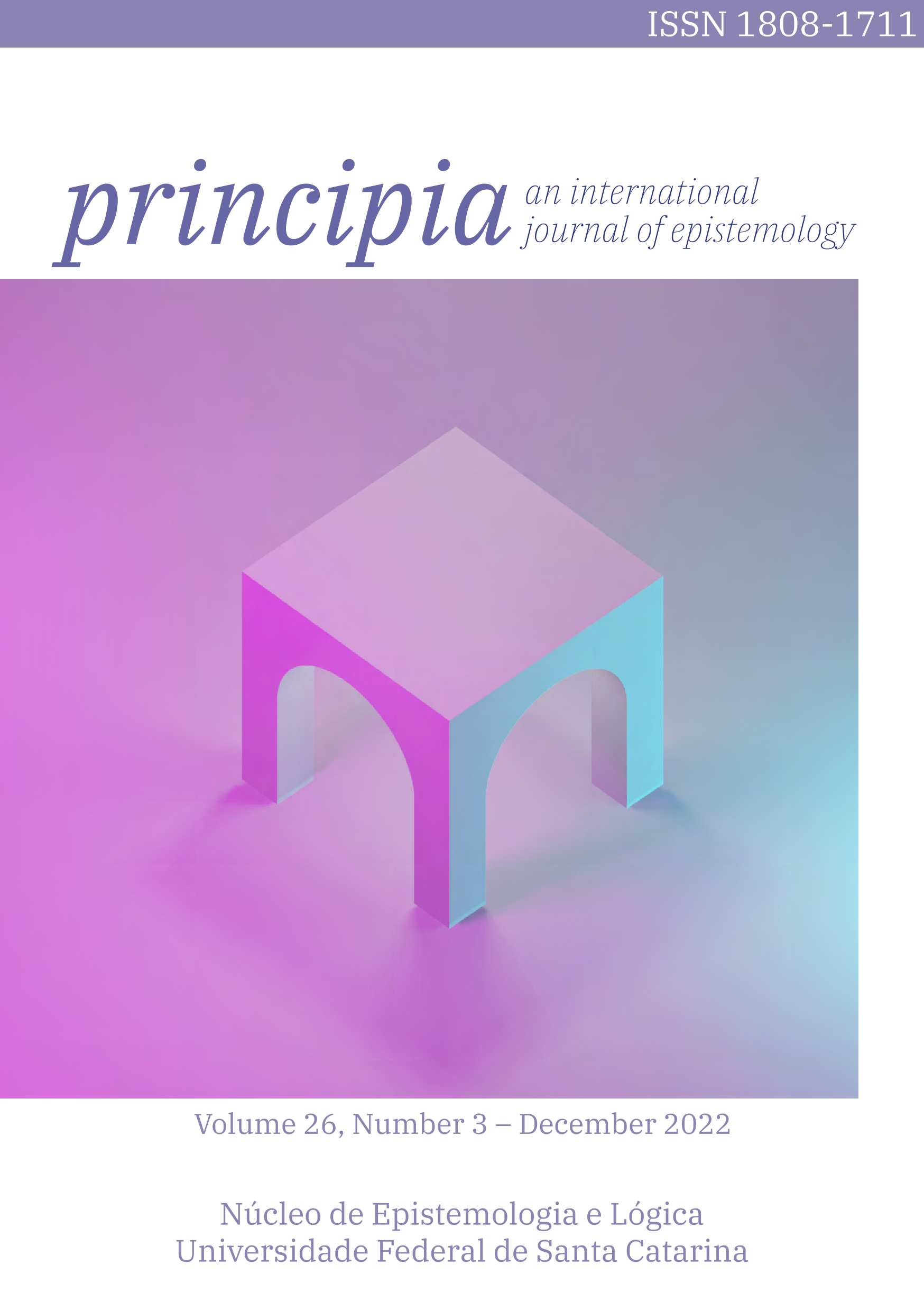The Faithfulness Problem
DOI:
https://doi.org/10.5007/1808-1711.2022.e84395Palavras-chave:
Euclidean proof, formal proof, deductive reasoning, suppression taskResumo
When adopting a sound logical system, reasonings made within this system are correct. The situation with reasonings expressed, at least in part, with natural language is much more ambiguous. One way to be certain of the correctness of these reasonings is to provide a logical model of them. To conclude that a reasoning process is correct we need the logical model to be faithful to the reasoning. In this case, the reasoning inherits, so to speak, the correctness of the logical model. There is a weak link in this procedure, which we call the faithfulness problem: how do we decide that the logical model is faithful to the reasoning that it is supposed to model? That is an issue external to logic, and we do not have rigorous formal methods to make the decision. The purpose of this paper is to expose the faithfulness problem (not to solve it). For that purpose, we will consider two examples, one from the geometrical reasoning in Euclid’s Elements and the other from a study on deductive reasoning in the psychology of reasoning.
Referências
Adam, C.; Herzig, A.; Longin, D. 2009. A logical formalization of the OCC theory of emotions. Synthese 168: 201-248.
Avigad, J.; Dean, E.; Mumma, J. 2009. A formal system for Euclid’s Elements. The Review of Symbolic Logic 2: 700-768.
Besold, T. R.; Garcez, A. D.; Stenning, K.; van der Torre, L.; van Lambalgen, M. 2017. Reasoning in non-probabilistic uncertainty: Logic programming and neural-symbolic computing as examples. Minds and Machines 27: 37-77.
Byrne, R. M. J. 1989. Suppressing valid inferences with conditionals. Cognition 31: 61-83.
Brun, G. 2014. Reconstructing arguments: Formalization and reflective equilibrium. Logical Analysis and History of Philosophy 17: 94-129.
Dal Magro, T. & García-Perez, M. J. 2019. On Euclidean diagrams and geometrical knowledge. Theoria. An International Journal for Theory, History and Foundations of Science 34(2): 255-276.
Dicher, B. 2021. Reflective equilibrium on the fringe. Dialectica 74(2): 71-94.
Evans, J. 2005. Deductive reasoning. In: K. J. Holyoak & R. G. Morrison (eds.), The Cambridge handbook of thinking and reasoning, p. 169-184. Cambridge: Cambridge University Press.
Hamami, Y.; Mumma, J.; Amalric, M. 2021. Counterexample search in diagram-based geometric reasoning. Cognitive Science 45(4): e12959
Heath, T. H. 1956. The thirteen books of Euclid’s Elements, second edition unabridged. New York: Dover Publications.
Hedman, S. 2004. A first course in logic. Oxford: Oxford University Press.
Macbeth, D. 2010. Diagrammatic reasoning in Euclid’s Elements. In: B. v. Kerkhove; J. de Vuyst; J. P. v. Bendegem (eds.), Philosophical perspectives on mathematical practice, p. 235-267. London: College Publications.
Manders, K. 2008. The Euclidean diagram. In: P. Mancosu (ed.), The philosophy of mathematical practice, p. 80-133. Oxford: Oxford University Press.
Manktelow, K. 2012. Thinking and reasoning: an introduction to the psychology of reason, judgment and decision making. London: Psychology Press.
Martin, B. & Hjortland, O. 2021.Logical predictivism. Journal of Philosophical Logic 50: 285-318.
Michels, R. 2021. The formalization of arguments. Dialectica 74(2): 1-33.
Netz, R. 1999. The shaping of deduction in Greek mathematics. Cambridge: Cambridge University Press.
Novaes, C. D. 2012. Formal languages in logic: A philosophical and cognitive analysis. Cambridge: Cambridge University Press.
Payette, G. & Wyatt, N. 2018. How do logics explain? Australasian Journal of Philosophy 96(1): 157-167.
Peregrin, J. & Svoboda, V. 2017. Reflective equilibrium and the principles of logical analysis. New York: Routledge.
Pijnacker, J.; Geurts, B.; van Lambalgen, M.; Buitelaar, J.; Hagoort, P. 2010. Reasoning with exceptions: an event-related brain potentials study. Journal of Cognitive Neuroscience 23: 471-480.
Reinmuth, F. 2021. Holistic inferential criteria of adequate formalization. Dialectica 74(2): 115-149.
Sattler, U.; Calvanese, D.; Molitor, R. 2007. Relationships with other formalisms., In: F. Baader; D. L. McGuinness; D. Nardi; P. F. Patel-Schneider (eds.), The description logic handbook, p. 142-183. Cambridge: Cambridge University Press.
Stenning, K. & van Lambalgen, M. 2001. Semantics as a foundation for psychology: A case study of Wason’s selection task. Journal of Logic, Language and Information 10: 273–317.
Stenning, K. & van Lambalgen, M. 2004a. Evolutionary considerations on logical reasoning. https://www.researchgate.net/publication/2896327_Evolutionary_Considerations_on_Logical_Reasoning. Access: 29/09/2021.
Stenning, K. & van Lambalgen, M. 2004b. A working memory model of relations between interpretation and reasoning. https://www.researchgate.net/publication/239015102_A_working_memory_model_of_relations_between_interpretation_and_reasoning. Access: 29/09/2021.
Stenning, K. & van Lambalgen, M. 2008. Human reasoning and cognitive science. Cambridge: MIT Press.
Stenning, K. & van Lambalgen, M. 2010. The logical response to a noisy world. In: M. Oaksford & N. Chater (eds.), Cognition and conditionals: Probability and logic in human thinking, p. 85-102. Oxford: Oxford University Press. https://www.researchgate.net/publication/286784975_The_logical_response_to_a_noisy_world. Access: 29/09/2021.
Stenning, K. & van Lambalgen, M. 2019. Reasoning and discourse coherence in autism spectrum disorder. In: K. Morsanyi & R. Byrne (eds.), Thinking, reasoning, and decision making in autism, p. 135-155. London: Routledge. https://www.researchgate.net/publication/330324480_REASONING_AND_DISCOURSE_COHERENCE_IN_AUTISM_SPECTRUM_DISORDER. Access: 29/09/2021.
Varga, A.; Stenning, K.; Martignon, L. 2015. There is no one logic to model human reasoning. The case for interpretation. Conference Paper. https://www.researchgate.net/publication/280114264_There_is_no_one_logic_to_model_human_reasoning_The_case_for_interpretation. Access: 29/09/2021.
Venema, G. A. 2012. Foundations of geometry. Boston: Pearson.
Downloads
Publicado
Edição
Seção
Licença
Copyright (c) 2022 Mario Bacelar Valente

Este trabalho está licenciado sob uma licença Creative Commons Attribution-NonCommercial-NoDerivatives 4.0 International License.

A obra Principia de http://www.periodicos.ufsc.br/index.php/principia/index foi licenciada com uma Licença Creative Commons Atribuição-NãoComercial-SemDerivações 4.0 Internacional.
Com base na obra disponível em www.periodicos.ufsc.br.



